Welcome to our free classical music site

Do you write about classical music? Are you a blogger? Want to team up with Classical Connect? Send us a message, let's talk!

Do you write about classical music? Are you a blogger? Want to team up with Classical Connect? Send us a message, let's talk!
This Week in Classical Music: May 8, 2023. A Listless List. A whole bunch of composers were born this week, and none of them inspire us. This may change with time: many of our.jpg) musical attachments ebb and flow. Let’s list the more interesting names: two Frenchmen, born on the same day, May 12th, three years apart: Jules Massenet in 1842 and Gabriel Fauré in 1845. Massenet is famous (or at least known) for his operas; two of them, Manon and Werther, are staged often. His most popular piece, though, is not vocal: it is Meditation, from his opera Thaïs, for the violin and orchestra. Here it is played by Mischa Elman, at his Russian Romantic best. While Massenet was rather conservative, Fauré, was forward-looking and influenced many composers of the early 20th century. Here is Fauré’s Pavane, performed by the Berlin Philharmonic under the baton of Simon Rattle.
musical attachments ebb and flow. Let’s list the more interesting names: two Frenchmen, born on the same day, May 12th, three years apart: Jules Massenet in 1842 and Gabriel Fauré in 1845. Massenet is famous (or at least known) for his operas; two of them, Manon and Werther, are staged often. His most popular piece, though, is not vocal: it is Meditation, from his opera Thaïs, for the violin and orchestra. Here it is played by Mischa Elman, at his Russian Romantic best. While Massenet was rather conservative, Fauré, was forward-looking and influenced many composers of the early 20th century. Here is Fauré’s Pavane, performed by the Berlin Philharmonic under the baton of Simon Rattle.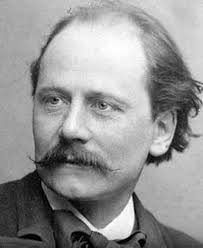
Carl Stamitz, the eldest son of Johann Stamitz, both prominent representatives of the Mannheim School, was baptized on May 8th of 1745. The American composer and pianist, Louis Moreau Gottschalk was born on that day in 1829 in New Orleans. Even if his music is mostly forgotten, his life was fascinating, and we’ll return to him someday. Giovanni Battista Viotti, an Italian violin virtuoso and composer, was born on May 12th of 1755. Viotti composed 29 violin concertos, some of them still in the active repertory, but we didn’t have a single piece of his in our library. We’re correcting the omission with this performance of his Violin concerto no. 22 with the wonderful Belgian-Romanian violinist Lola Bobesco. Kurt Redel conducts the Staatsphilharmonie Rheinland-Pfalz orchestra. Another Italian, Giovanni Paisiello, was born on May 9th of 1740. His most popular opera was Il Barbiere di Siviglia, composed in 1782 with the libretto adapted from Beaumarchais’s play, as was Rossini’s famous masterpiece, written some 36 years later.
Milton Babbitt was one of the most interesting (and difficult) American composers of the 20th century, and we wrote about him here. And speaking of fascinating lives, Arthur Lourié’s certainly was: he was linked, romantically or otherwise, with a good part of the Russian Silver Age artists, from the poet Anna Akhmatova to the painter Sudeikin, to Stravinsky and Vera de Bosset, Stravinsky’s eventual wife. Some of these relationships were rather unconventional; we’ve touched upon them here.
Two conductors were also born this week, Carlo Maria Giulini, on May 9th of 1914, and Otto Klemperer, on May 14th of 1895. Giulini, together with Arturo Toscanini, Victor de Sabata, and Claudio Abbado, was one of the few truly great Italian conductors (we probably should add Giuseppe Sinopoli and Riccardo Muti to the list). During his long career (he died at the age of 91) Giulini was closely associated with the Chicago Symphony Orchestra, London's Philharmonia, the Vienna Philharmonic, and sever other major ensembles. The number of prominent German 20th-century conductors is much larger, and Otto Klemperer was always considered one of the best. We wrote about him recently here. An interesting note: Giulini’s first instrument was the viola, and as a young man, he played in the orchestra of the Accademia di Santa Cecilia in Rome. Among the conductors whose music-making affected him the most were the Germans: Wilhelm Furtwängler, Bruno Walter – and Klemperer.Permalink
This Week in Classical Music: May 1, 2023. Pfitzner, Double Birthday and Alessandro Scarlatti. The German composer Hans Pfitzner was born in, of all places, Moscow, Russia, on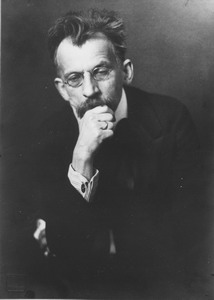 May 5th of 1869. We wanted to write about him not because of his talent but because of the period he lived in, the one preceding the 1933 Nazi takeover and then the Nazi period in Germany and later Austria. We find this time frame of Austro-German music fascinating. Never before were music and politics as intertwined as then and there, and never in modern times were the ethics of the musicians tested to the same degree. Then it occurred to us that just two weeks ago we wrote about Max von Schillings, whose path was somewhat similar to Pfitzner’s. So, we decided to return to Pfitzner at a later date. Pfitzner was a better composer and not as rabid a Nazi supporter as Schillings, so we feel that we can play some of his music. Here are Three Preludes from his most successful opera, “Palestrina” (preludes to Acts I, II, and III). Christian Thielemann conducts the orchestra of the Deutsche Oper Berlin.
May 5th of 1869. We wanted to write about him not because of his talent but because of the period he lived in, the one preceding the 1933 Nazi takeover and then the Nazi period in Germany and later Austria. We find this time frame of Austro-German music fascinating. Never before were music and politics as intertwined as then and there, and never in modern times were the ethics of the musicians tested to the same degree. Then it occurred to us that just two weeks ago we wrote about Max von Schillings, whose path was somewhat similar to Pfitzner’s. So, we decided to return to Pfitzner at a later date. Pfitzner was a better composer and not as rabid a Nazi supporter as Schillings, so we feel that we can play some of his music. Here are Three Preludes from his most successful opera, “Palestrina” (preludes to Acts I, II, and III). Christian Thielemann conducts the orchestra of the Deutsche Oper Berlin.
May 7th is special: Pyotr Tchaikovsky and Johannes Brahms were both born on this day, Tchaikovsky in 1840 and Brahms seven years earlier, in 1833. This is a rather unfortunate coincidence as both of them deserve separate entries. On the other hand, we’ve written so many entries about these composers, together and separately, that we’ll skip them this time.
These days Alessandro Scarlatti’s son Domenico is much better known than his father, but we think this is a purely technical issue: Alessandro was famous for his operas whereas Domenico – for his small clavier sonatas. It’s much easier to squeeze a three-minute piano piece into a recital or as a filler on a classical music radio station than stage a three-hour opera production. Scarlatti composed 65 operas, most of them in three acts. The exceptions being the famous (or as famous as Alessandro Scarlatti’s opera can get), Il Mitridate Eupatore, and Il trionfo della libertà are in five acts; both composed in 1707. Of all of his operas, probably five have been recorded (his oratorios fared a little bit better; Scarlatti wrote more than 30 of them, and being shorter, they are easier to produce). Alessandro Scarlatti was born on May 2nd of 1660 in Palermo. He spent most of his time in Rome and Naples and is considered “the father” of the Neapolitan opera. Even though opera was his favorite art form, he also wrote some church and orchestral music. We can listen to two examples: here’s his short (just five minutes) Concerto Grosso no. 4, performed by the ensemble Europa Galante under the direction of Fabio Biondi. It was composed around 1715. And here is Kyrie, from his St. Cecilia Mass (1720). The Wren orchestra, the choir of St. John’s College, Cambridge, and the soloists are led by George Guest.Permalink
This Week in Classical Music: April 24, 2023. Benedetto Pamphili. Occasionally we write about historical figures that, while not directly involved in composing or making music, greatly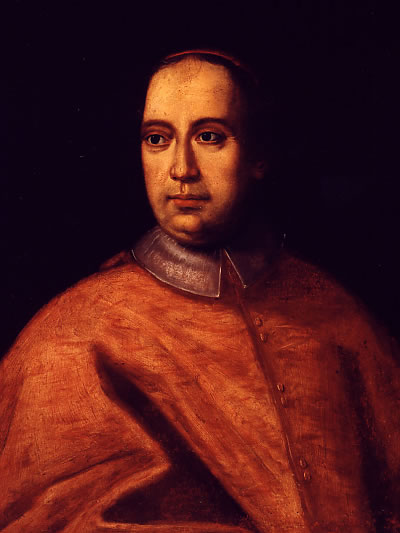 affected musical culture, for example, through their patronage, as librettists, or as music producers. Queen Christina is probably the most famous example of a patron. In a very different way, Pietro Metastasio, who wrote libretti to operas by Vinci, Caldara, Hasse, and many other opera seria composers, was also very influential. And then there was Lorenzo da Ponte: we know him as the librettist to Mozart’s Don Giovanni, Così fan tutte, and The Marriage of Figaro, but he also wrote libretti for 25 other operas by 11 composers, Antonio Salieri among them. The famous impresario Sol Hurok is an example of a powerful producer who shaped several musical careers.
affected musical culture, for example, through their patronage, as librettists, or as music producers. Queen Christina is probably the most famous example of a patron. In a very different way, Pietro Metastasio, who wrote libretti to operas by Vinci, Caldara, Hasse, and many other opera seria composers, was also very influential. And then there was Lorenzo da Ponte: we know him as the librettist to Mozart’s Don Giovanni, Così fan tutte, and The Marriage of Figaro, but he also wrote libretti for 25 other operas by 11 composers, Antonio Salieri among them. The famous impresario Sol Hurok is an example of a powerful producer who shaped several musical careers.
Cardinal Benedetto Pamphili, whom we are celebrating today, was prominent in all three areas: he was an important benefactor, he wrote several libretti, and he staged many productions, some of which were premiers. Benedetto Pamphili was born in Rome on April 25th of 1653 into a prominent family whose name in Italian is often spelled Pamphilj, the ending “j” indicating a long “e” sound. Benedetto’s great-grandfather was Pope Innocent X, whose portrait you can see below. (The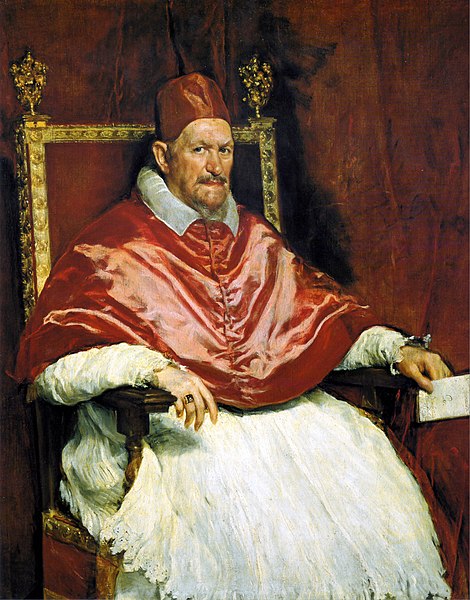 portrait, one of the greatest ever created, was painted by Diego Velázquez. It now hangs in a separate room in Galleria Doria Pamphilj; it alone is worth the price of the ticket. Read more about it here). Benedetto’s parents were Cardinal Camillo Pamphilj and Olimpia Aldobrandini, from a no less powerful Aldobrandini family. In order to marry Olimpia, Camillo had to renounce his cardinalship. The Palazzo Doria Pamphilj, which houses the gallery, was part of Olimpia’s dowry; prior to her marriage, it was called Palazzo Aldobrandini (the original Palazzo Pamphilj is on Piazza Navona and is now owned by the Brazilian embassy).
portrait, one of the greatest ever created, was painted by Diego Velázquez. It now hangs in a separate room in Galleria Doria Pamphilj; it alone is worth the price of the ticket. Read more about it here). Benedetto’s parents were Cardinal Camillo Pamphilj and Olimpia Aldobrandini, from a no less powerful Aldobrandini family. In order to marry Olimpia, Camillo had to renounce his cardinalship. The Palazzo Doria Pamphilj, which houses the gallery, was part of Olimpia’s dowry; prior to her marriage, it was called Palazzo Aldobrandini (the original Palazzo Pamphilj is on Piazza Navona and is now owned by the Brazilian embassy).
Benedetto, who inherited a fortune, also had a considerable income from numerous ecclesiastical positions he was granted by Pope Innocent XI. He spent much of it on art and patronage. Benedetto was a gifted writer and was admitted into two prestigious Academies: Accademia degli Umoristi, a literary society whose members were some of the best writers of the time (despite its name the Academy wasn’t necessarily dedicated to humoristic arts), and Accademia dell'Arcadia, about which we wrote an entry some time ago. As music was Benedetto’s favorite art, he applied his literary talents to writing libretti. Operas were prohibited in Rome by Pope Clement XI in 1703, so most of these libretti were for oratorios and cantatas, which temporarily replaced operas as accepted genres (texts for 88 cantatas are extant). A few of Benedetto’s operas were staged before the prohibition went into effect, for example, Alessandro Scarlatti’s La santa Dimna, presented in Palazzo Doria Pamphilj in 1687.
Benedetto employed several maestro di musica, among them Lulier and Cesarini. Arcangelo Corelli played in his orchestra and was handsomely rewarded for it. Bernardo Pasquini, a composer of operas and oratorios, was also supported by Benedetto, as was Giovanni Bononcini. His most famous charge was Handel during the young composer’s stay in Rome. They became friends and Handel dedicated several cantatas and oratorios to his patron.
Benedetto held weekly musical events in his palace, as did some other powererful cardinals, like Pietro Ottoboni and Carlo Colonna; he also sponsored productions in other theaters. What is interesting about these productions is the size of the orchestras they employed. We are used to the staging of Baroque operas supported by scaled-down groups, often consisting of just several players: a couple of violins, a viola da gamba, a theorbo, and a harpsichord. According to Lowell Lindgren, Benedetto employed 32 musicians in Scarlatti's Il trionfo della gratia and 60 for Lulier's S Maria Maddalena de' pazzi. Maybe the musical accompaniment of Baroque operas doesn’t have to sound so thin after all.Permalink
This Week in Classical Music: April 17, 2023. Schillings and the problem of evil. In his “little tragedy” Mozart and Salieri, the Russian poet Alexander Pushkin made a profound, if not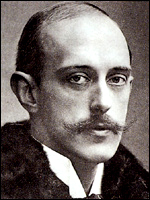 necessarily true statement: “Genius and villainy are two things incompatible.” We’d like to believe it to be true, and in some higher sense it should be true, but we know that history is full of villainous geniuses. As far as music is concerned, Richard Wagner’s name is the first to come to mind. He was a vile antisemite and made statements that today are difficult to comprehend. One thing we’d like to make clear about Wagner is that in no way was he responsible for the atrocities committed by the Nazis, though much of them were accompanied by his music. Wagner’s music was favored by Hitler, but the Führer also loved Bruckner and Beethoven. Wagner’s place in the Nazi culture was unique, partly because of the Bayreuth Festival, run by the antisemitic Winifred Wagner, the wife of Richard’s son Siegfried and Hitler’s dear friend, but in no way does this make Wagner, as terrible a person as he was, an accomplice. Then there was Carlo Gesualdo, Prince of Venosa and Count of Conza, who murdered his wife and Fabrizio Carafa, Duke of Andria, after finding them in flagrante. Alessandro Stradella, a wonderful composer, embezzled money from the Catholic church, seduced and abandoned many women, and was killed by three assassins hired by a nobleman who found out that Stradella had become a lover of his mistress (or, in another version of the story, the nobleman’s sister). One person we find especially fascinating is the painter of genius, Caravaggio, who murdered several people, maimed many more, belonged to a gang, was arrested on many occasions, and had fled from justice for half of his life. We tend not to remember these things when we look at his pictures, some of the most profound ever created.
necessarily true statement: “Genius and villainy are two things incompatible.” We’d like to believe it to be true, and in some higher sense it should be true, but we know that history is full of villainous geniuses. As far as music is concerned, Richard Wagner’s name is the first to come to mind. He was a vile antisemite and made statements that today are difficult to comprehend. One thing we’d like to make clear about Wagner is that in no way was he responsible for the atrocities committed by the Nazis, though much of them were accompanied by his music. Wagner’s music was favored by Hitler, but the Führer also loved Bruckner and Beethoven. Wagner’s place in the Nazi culture was unique, partly because of the Bayreuth Festival, run by the antisemitic Winifred Wagner, the wife of Richard’s son Siegfried and Hitler’s dear friend, but in no way does this make Wagner, as terrible a person as he was, an accomplice. Then there was Carlo Gesualdo, Prince of Venosa and Count of Conza, who murdered his wife and Fabrizio Carafa, Duke of Andria, after finding them in flagrante. Alessandro Stradella, a wonderful composer, embezzled money from the Catholic church, seduced and abandoned many women, and was killed by three assassins hired by a nobleman who found out that Stradella had become a lover of his mistress (or, in another version of the story, the nobleman’s sister). One person we find especially fascinating is the painter of genius, Caravaggio, who murdered several people, maimed many more, belonged to a gang, was arrested on many occasions, and had fled from justice for half of his life. We tend not to remember these things when we look at his pictures, some of the most profound ever created.
The musician whom we decided to write about this week never had the talent of the artists just mentioned, but neither were his sins as deep; nonetheless, his story, which is much closer to our time, seems to be more relevant. His name was Max Schillings, he was born on April 19th of 1868 in Düren, the Kingdom of Prussia. He studied the piano and the violin in Bonn and later entered the University of Munich, where he took courses in law, philosophy, and literature. While in Munich, he met Richard Strauss who became his friend for life. In 1892 Schillings was appointed assistant stage conductor at Bayreuth; in 1903 he was made professor in Munich (Wilhelm Furtwängler was one of his students). In 1908 he became the assistant to the Director of the Royal Theater in Stuttgart, the city’s main opera house, where he staged several premieres, including Strauss’s Ariadne auf Naxos; later he also conducted Strauss’s Salome and Elektra. By then he had composed several operas, most of them unsuccessful imitations of Wagner. Then, in 1915, he had a breakthrough with his opera Mona Lisa, which became the most often staged opera of the time. In 1918 Schillings succeeded Richard Strauss as the Intendant of the State Opera in Berlin (we know it as Staatsoper Unter den Linden; Barenboim lead it for years). He then spent several years outside of Germany, conducting and staging operas in Europe and the US. Upon his return in 1932, he was appointed President of the Prussian Academy of the Arts.
Schillings was a rabid antisemite, a nationalist and an opponent of the Weimar Republic. As soon as he became the President of the Academy, he fired some of the most talented members, among them Heinrich and Thomas Mann; Alfred Döblin, the author of Berlin Alexanderplatz; the composer Franz Werfel. He terminated Arnold Schoenberg’s contract and sent Franz Schreker into retirement. God only knows what else he would have done had he lived through the Nazi period, but he died on July 24th of 1933, four months after the Enabling Act gave Hitler dictatorial powers. We don’t want to keep Schillings’s music in our library, but you can find Mona Lisa on YouTube.Permalink
This Week in Classical Music: April 10, 2023. Pletnev and Caballé. Mikhail Pletnev is a wonderful pianist and an interesting conductor. He was born on April 14th of 1957 in the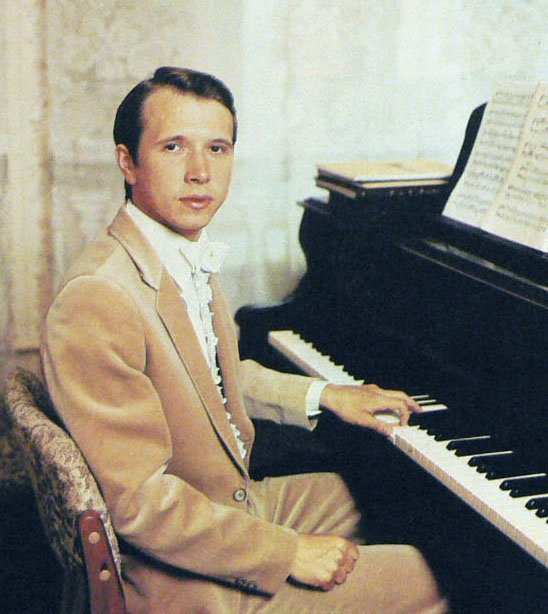 northern Russian city of Arkhangelsk. In 1978, when he was 21, Pletnev won the first prize at the sixth Tchaikovsky competition. That brought him international recognition and his career took off. He debuted in the US the following year and since then has performed in all major venues and played concerts with the best conductors, Claudio Abbado, Bernard Haitink, Lorin Mazel, and Zubin Mehta among them. As a pianist, Pletnev has a special affinity with Rachmaninov and is acknowledged as one of the best performers of his music. In 1990, Pletnev founded the Russian National Orchestra (RNO), the first non-governmental orchestra in the country since 1917, and developed it into one of the best orchestras in Russia. The NRO recordings of Tchaikovsky’s symphonies are especially good. Everything changed in 2022 with the Russian aggression against Ukraine. Pletnev’s reaction was both negative and direct. In an interview, he said: “Who starts the wars? Only stupid politicians. Not a single normal person likes the war. But the politicians use propaganda and manipulation, and they use them for their own benefit, not ours.” Of course, in a country with only one politician, Mr. Putin, this couldn’t be tolerated. First, the Russian government fired RNO’s executive director, a Pletnev supporter, and then practically banned Pletnev from conducting his own orchestra. Since then, Pletnev has created another ensemble he calls the Rachmaninoff International Orchestra. Among its members are musicians from Eastern and Western Europe, and 18 former members of the RNO.
northern Russian city of Arkhangelsk. In 1978, when he was 21, Pletnev won the first prize at the sixth Tchaikovsky competition. That brought him international recognition and his career took off. He debuted in the US the following year and since then has performed in all major venues and played concerts with the best conductors, Claudio Abbado, Bernard Haitink, Lorin Mazel, and Zubin Mehta among them. As a pianist, Pletnev has a special affinity with Rachmaninov and is acknowledged as one of the best performers of his music. In 1990, Pletnev founded the Russian National Orchestra (RNO), the first non-governmental orchestra in the country since 1917, and developed it into one of the best orchestras in Russia. The NRO recordings of Tchaikovsky’s symphonies are especially good. Everything changed in 2022 with the Russian aggression against Ukraine. Pletnev’s reaction was both negative and direct. In an interview, he said: “Who starts the wars? Only stupid politicians. Not a single normal person likes the war. But the politicians use propaganda and manipulation, and they use them for their own benefit, not ours.” Of course, in a country with only one politician, Mr. Putin, this couldn’t be tolerated. First, the Russian government fired RNO’s executive director, a Pletnev supporter, and then practically banned Pletnev from conducting his own orchestra. Since then, Pletnev has created another ensemble he calls the Rachmaninoff International Orchestra. Among its members are musicians from Eastern and Western Europe, and 18 former members of the RNO.
Here are several piano recordings by Mikhail Pletnev. First, Rachmaninov’s Corelli Variations, recorded live in Moscow in 2001 (here). Then, another live recording, made in Luxemburg in 2015: a rather idiosyncratic interpretation of Chopin’s Nocturne in C-sharp minor op. posth. (here). And lastly, from Carnegie Hall, also live, the year 2000 recording of Chopin’s Scherzo no. 1 (here).
The great Spanish soprano Montserrat Caballé, “La Superba,” was born on April 12th of 1933 in Barcelona. Here she sings the aria Donde Lieta Usci from Puccini’s La Bohème. Charles Mackerras conducts the London Symphony Orchestra.
PermalinkThis Week in Classical Music: April 3, 2023. Two Italian Tenors. Only one of these singers has an anniversary this week, and that’s Franco Corelli, who was born on April 9th of 1921 in.jpg) Ancona. Another tenor is Beniamino Gigli, whose name we mentioned several weeks ago when we were celebrating the birthday of the great Enrico Caruso. We promised then to write about Gigli, probably second only to Caruso among tenors of the first half of the 20th century. Gigli was born on March 20th of 1890, but with Bach and Rachmaninov’s 150th anniversaries intervening, this is the earliest we could get to Gigli.
Ancona. Another tenor is Beniamino Gigli, whose name we mentioned several weeks ago when we were celebrating the birthday of the great Enrico Caruso. We promised then to write about Gigli, probably second only to Caruso among tenors of the first half of the 20th century. Gigli was born on March 20th of 1890, but with Bach and Rachmaninov’s 150th anniversaries intervening, this is the earliest we could get to Gigli.
Forty years separate Gigli from Corelli; that gap affected their legacies in many ways, but two of them are very important: one is technology, the other – politics. Gigli made a large number of records, but the recording technology of his time was rather poor, and the sound quality of his shellac records cannot compare with the ones made by Corelli. Subsequently, we rarely can hear the tone quality for which Gigli was famous. And politics is the second important factor: Gigli lived during the fascist years of Mussolini’s reign, and as was the case with many German, Soviet, and Italian musicians of the time, he compromised himself politically and ethically.
Beniamino Gigli was born in Recanati, a small town not far from Ancona on the Adriatic side of Italy. In 1914 he won a competition in Parma, and later that year made a successful début in Ponchielli’s La Gioconda. His career took off almost immediately, and he was invited to sing in all major opera theaters of Italy, from San Carlo in Naples to La Scala in Milan. In 1917 he sang in Spain and in 1920 made a highly successful debut in New York at the Met. He stayed in the US for the next 12 years, becoming, after Caruso’s death in 1921, the Met’s most popular tenor, even though the opera’s roster also included such singers as Giacomo Lauri-Volpi and Giovanni Martinelli. Even though the public called Gigli “Caruso Secondo,” the comparison is not fair: Caruso’s voice was bigger and darker than Gigli’s, whereas Gigli’s was “sweeter” and probably naturally more beautiful. In 1932, after refusing a pay cut, Gigli left the Met and returned to Italy. He became Mussolini’s favorite singer, which in itself, of course, is not a sin. Unfortunately, Gigli went much further: in 1937 he recorded the official hymn of the Italian fascist party, Giovinezza; in 1942 he wrote a book, Confidenze, in which he praised fascism. He valued his “friendship with Hitler, Goering and Goebbels. In 1944, he collaborated with the Germans after they occupied Rome. Were he in Germany at the end of the war, he would probably had been banned for years as a collaborator, but in Italy, he was forgiven almost immediately. Not everybody forgot his past, though: he wasn’t let into the US till 1955. That didn’t prevent Gigli from singing in Italy, Europe and South America.
Gigli’s recordings don’t do justice to his honeyed tone but we have two samples that seem to better reflect his voice. Here, from 1943, is his Vesti la giubba, from Leoncavallo’s I Pagliacci (it’s a live recording and we had to cut down part of the prolonged ovation). And here, from 1949, is Nessun dorma, from Puccin’s Turandot.
Gigli was one of Franco Corelli’s favorite singers; mostly self-taught, he learned to sing by listening to the recordings of Caruso, Lauri-Volpi and Gigli. Here’s Corelli’s rendition of Nessun dorma. Two years ago we celebrated Corelli’s 100th anniversary, you can read more about this great singer here.
Permalink